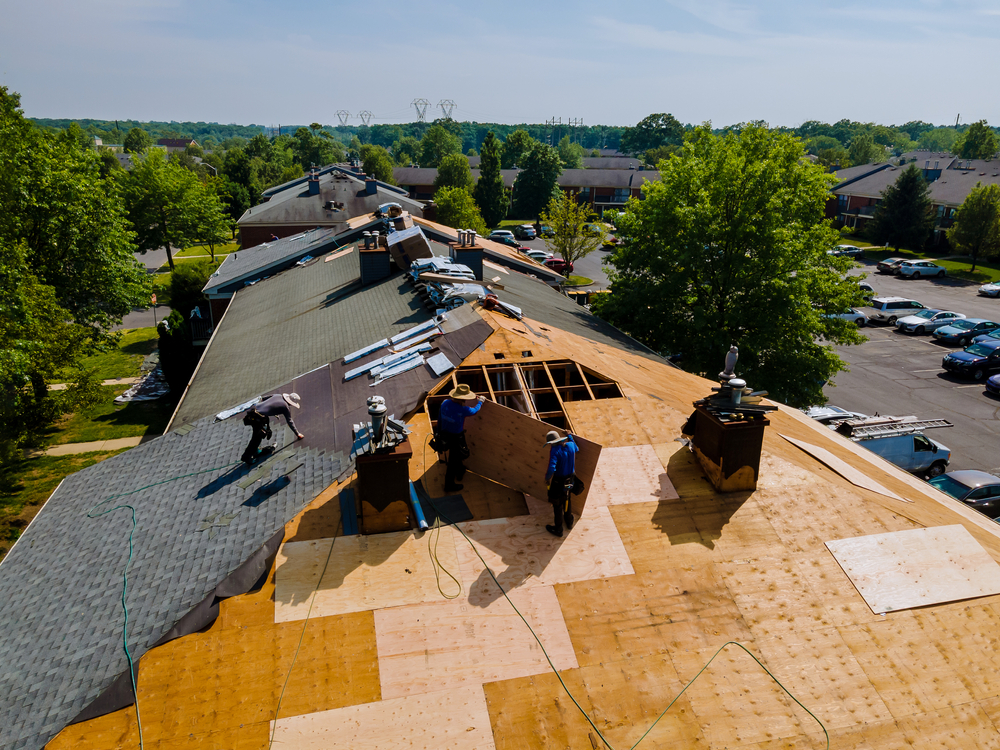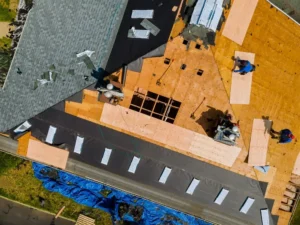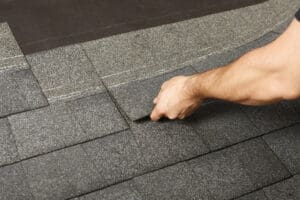Replacing a roof is a significant investment, but it’s necessary to protect your property from the elements and maintain its structural integrity. Many homeowners consider the average cost for a roof replacement in Texas, and many factors affect the total cost.
Understand these factors and learn how to select a new roof that fits your budget, style, and expectations.
Factors That Affect The Cost of Roof Replacement in Texas
Many factors affect the overall cost of a roof replacement, especially labor. Whether you choose a cheaper material like asphalt shingles or a higher-end material like slate is another major factor that can also affect your labor costs.
Size
The typical roof replacement cost ranges from $4.35 to $11 per square foot. Generally, the more square footage your home has, the higher your cost will be. Steeper roof pitches also increase the square footage of your roof.
Roof Pitch
If your roof is so steep that it requires special equipment to work on it for safety reasons, you might spend $1,000 to $3,000 extra on labor costs. Most roof pitches fall between 3:12 and 6:12, and 12:12 is a 45-degree angle. Anything over a 6:12 pitch is considered a more complicated, hazardous job for your roofers.
Materials
When you receive a cost estimate for roof replacement from your contractor, they will quote you by the “square.” One roofing square covers 100 square feet and usually costs between $150 and $1,500. For an average 2,200-square-foot home, roofing materials can cost anywhere from $3,690 to $36,900.
Labor
Roofing is a very skilled and labor-intensive job. You can expect to pay $200 to $350 per roofing square in labor costs or $2 per square foot. If you’re installing a tile or slate roof, labor costs can increase from $4 to $17 per square foot. Labor costs are also affected by the pitch of your roof and whether you need current roofing materials removed.
On average, labor makes up around 60% of the cost of your total roofing project.
Location
Similar to other home improvement projects, roof replacement costs are affected by local labor rates and fluctuating material prices. You can expect to pay more in metropolitan areas and places with higher costs of living.
If you live in an area with an extreme climate, you may want to install more expensive roofing materials that can withstand heat, cold, and heavy storms. Roofers will likely charge more if they have to work in extreme weather like severe cold or snow.
Permits
Building permits for a new roof can range from $100 to $1,000, depending on where you live. Some HOAs require pre-approval of color or style, so make sure you have approval before you begin the project.
Also, permits can sometimes take weeks to approve, so it’s a good idea to get them well ahead of time.
Inspections
Certain municipalities require a building inspector to perform inspections throughout the roof replacement process to ensure all processes are up to code. This may cost extra.
Full vs. Partial Roof Replacement
If only a portion of your roof needs to be replaced, you can do a partial roof replacement. Unsurprisingly, it will cost less to replace a portion of your roof instead of the whole thing, but you’ll still need to pay for permits and removal of the old roofing material. You may also pay more per square foot for materials, but the overall cost will be less than an entire new roof.
Other Factors & Expenses
Two other factors that may affect the cost of your roof replacement in Texas are disposing of the old roof materials and performing any necessary structural repairs. In addition to having your old roof materials removed, they need to be properly disposed of. Many roofers add this to labor costs.
Before installing a new roof, you’ll need to get an inspection and fix any existing issues like water damage, rotted wood, leaks, holes, pest infestations, and other structural problems. The cost to repair these issues depends on the problem and its severity.
Average Cost of Roof Replacement in Central Texas
The average cost of roof replacement in Texas ranges from $5,000 to $10,000. It can vary based on all of the above factors and the roofing contractor that you hire.
Material Costs Breakdown
Asphalt Shingles
Basic, three-tab asphalt shingles are the cheapest and most common types, costing between $4.25 to $8.25 per square foot. Asphalt shingles can be made from a variety of materials. Fiberglass shingles are less expensive, while composite shingles made from recycled material are more expensive.
Aluminum Shingles
Aluminum shingles are a step up from asphalt shingles that are not as pricey as higher-end tile or metal roofing options. They are somewhat resistant to saltwater corrosion and they cost $6.50 to $21 a square foot.
Cedar Shingles
Cedar shingles and shakes are some of the most common types of wooden roofing materials. Cedar shakes are similar to wood shingles and shakes made from spruce, redwood, pine, or other coniferous trees. Wooden roofs usually cost between $6.53 to $9.90 per square foot.
Clay Tiles
Clay tile roofing is one of the oldest roofing materials. It’s eco-friendly, highly durable, fire-resistant, and doesn’t trap heat, making it ideal for hot climates and wildfire-prone areas. It costs between $5.90 and $14.68 per square foot.
Copper Tiles
Copper tile roofing is highly durable, and lightweight, and is one of the most unique-looking roofing materials. It costs between $20 and $40 per square foot.
Flat Roofing
Ethylene propylene diene monomer (EPDM) roofing is a type of synthetic rubber roofing, often used for commercial properties. It’s on the cheaper end between $5.50 and $7.50 per square foot, but labor costs are higher to replace this kind of roofing.
Slate Tiles
Slate tile roofing is one of the most durable roofing materials—it can last 75 to 150 years. It’s on the more expensive end at $7.56 to $18.70 per square foot, and it can be too heavy for some roofs.
Standing Seam Metal Panels
Standing seam metal panels are a type of metal roofing that is highly durable and offers a sleek, streamlined look. It costs more than corrugated metal roofing, at $10 to $17 per square foot.
Steel Shingles
Similar to aluminum, stainless steel shingles are more expensive than asphalt but on the middle of the spectrum for metal roofing options. They cost between $7 to $20, depending on the quality of shingle used.
Zinc Tiles
Zinc tiles are the second most expensive metal roofing option because they are not as common and are one of the most corrosion-resistant roofing materials. They cost $14.50 to $21 per square foot.
Ways To Minimize The Cost of Your Roof Replacement in Texas
Know Your Roof Replacement Materials
The roofing material you select is the biggest single material cost in your roof replacement project. Shingle or tile cost is quoted on a per-square basis.
You can choose anything from rubber to galvanized steel or asphalt, slate, or copper. Asphalt is the most common roofing material because of its affordability, durability, and ease of installation.
Composite shingles made of fiberglass or cellulose base and coated with asphalt are less expensive but have a shorter lifespan. On the other end of the cost spectrum, is a metal like copper, which is highly durable but one of the most expensive options available.
When selecting a roofing material, consider your current budget but also the potential lifespan of your new roof.
Get Offseason Discounts
If you’re planning a roof replacement, wait until the slow season for roofers. The busiest seasons are summer and fall, so try to schedule your replacement during early-to-late winter or early-to-late spring.
File an Insurance Claim
Depending on your homeowner’s insurance policy and the reason you’re getting a roof replacement, a replacement may be covered by insurance. You should consult with an experienced roofer and get an inspection to assess the extent and cause of the roof damage and determine whether you may have a valid insurance claim.
Get Multiple Quotes
Seek comparable quotes from at least three professional, reputable roofing companies. Watch out for unusually low bids, and avoid roofers that require payment upfront.
Research Roofers
Ask friends or neighbors for recommendations on local roofing companies. Once you’re in contact with a roofer, ask them for customer referrals and pictures of comparable projects. Always ask for proof of bonding, licensing, and insurance, and check the validity through your local government before beginning work or making any payments.
Roof Repair vs. Replacement
Getting your roof repaired is less expensive than having it replaced, but it’s usually only a temporary fix. You can even spend more on repairs if your roof is in very poor condition. In the following circumstances, you should consider a roof replacement instead of repair:
- Your asphalt shingle roof is over 10 years old
- The damage is severe (e.g. exposed decking or water damage underneath the moisture barrier)
- Your roof has serious structural concerns
- You want to improve your home’s value and/or are considering selling soon
- You want to boost your home’s energy efficiency
In some cases, you might be able to save money and preserve the integrity of your roof with repairs. You might be able to opt for repair in the following situations:
- Your asphalt shingle is less than 10 years old
- Your roof is made of a highly durable material like tile, metal, or slate
- The damage is limited to a small or shallow area
- The damage is superficial, meaning only a shingle or two has come loose
Partial replacement may also be an option if your roof damage is limited to one side of the house. However, consider your long-term budget, as replacing your roof in phases will cost more than a full replacement done at once.
Roof Replacement Financing Options
Roof Warranty & Homeowners Insurance
If your roof sustained damage from climate or weather-related events like thunderstorms, hail, wind, snow, tornadoes, or hurricanes, your replacement may be covered under your homeowner’s insurance policy. Damage from falling trees, limbs, or other debris may also be covered.
Personal Loans
Personal loans can be a good option because loan terms are usually flexible and allow you to select a short-term loan or a longer one if necessary.
Home Equity Loans
A home equity loan uses the equity in your home to borrow against, using the home as collateral. Also called a second mortgage, it’s often used for large home-related expenditures like roof replacement. Payments and terms on a home equity loan are similar to those on a standard loan with a fixed interest rate, but the interest may be tax-deductible.
Home Equity Line of Credit
A home equity line of credit or HELOC allows you to borrow against the equity in your home while using the home as collateral. It’s similar to a home equity loan but the difference is that the line of credit is open or revolving, and it’s usually accompanied by a variable interest rate. You can borrow against it and pay it back, but it remains open so you can borrow against it again.
Because the full cost of a roof replacement is specified in advance, a personal loan or home equity loan with a fixed interest rate might be a better option than a home equity line of credit.
Find Out How Much a Roof Replacement Will Cost You in Texas
If you need a roof replacement or aren’t sure whether you need repairs or replacement, contact the experienced roofing contractors at NewRüf. We provide full residential and commercial roofing services, including flexible financing options and assistance with roof replacement insurance claims.
Our crew is fully licensed, insured, and trained in providing thorough inspections, reliable repairs, and efficient replacements. We work with all materials from asphalt shingles to metal roofing and slate.
If you have any questions about roof replacement, don’t hesitate to contact us. We can help with cost considerations and finding the perfect material and style for your property.







